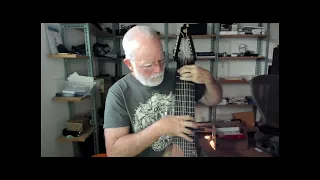There is a score/tablature, fretboard diagrams, and (to be done) youtube video instructions, that will help you along the way.
The Score (and tabs) to go along with the diagrams below is available Here even if you can't read music well (or at all), Bringing up the score is very useful. I can't emphasize this enough... why?
Throughout the instructions i also have links to Musescores that contain broken out parts of the main score to make it easier to bring up and loop on
Keep in mind, you can arrange these parts as you like. Playing the entire thing can be a workout so feel free to start with a condensed version, like the one below, and then work up to playing the whole thing
Or just have fun at the start by playing an extended version of the intro like I do in the clip below.
summary ---- Intro AA B CC S E B S E FF GG G-outro HH BE BC GG G-outro FF C-bar1,2 G-outro-bar1,2
Example shorter version ---- Intro AA B CC S E(1st half) B S E(1st half) GG G-outro FF C-bar1,2 G-outro-bar1,2
Traditionally, the intro is improvised. Here's an example one
In the score, I have written out an intro section for use use as a starting point. I've diagrammed some of the bass chords I tend to use when improvising the intro section you may find useful. These chords are used in the written out intro. You'll want to get comfortable moving between them. They typically arpeggiate upwards.

Bring up the score and use the loop button to the right of the play [>] button to set the start measure to 1 and end measure to 2. Then use the play button to loop those two bars. Use this procedure for each diagram as you go.. You can use the slider next to the watch icon to slow down the loop.

Play the full chord on the Cm7 and arpeggiate the Bb drone chord. On a 'Classic' tuning you'll have to move the pattern down one string and 5 frets closer to the bridge to avoid clashing with the CM7 bass chord
Part A is a riff that you can repeat as you see fit. If you are playing with a drummer you might want to vamp on it and let them have an introductory bit of solo-ing over it.
It also doubles as good way to practice to get that Bb Eb -Bb bass riff down pat, as the rest of the song gets a bit more challenging after this section and this riff continues on thoughout the song.
note the (notes, notes, notes) format in the diagram captions below. The two commas group the notes into the 3-3-2 rythmn pattern of the song
The musescore
for part C
The musescore for parts S & E
The musescore
for part F
The musescore
for part G
The musescore
for part H